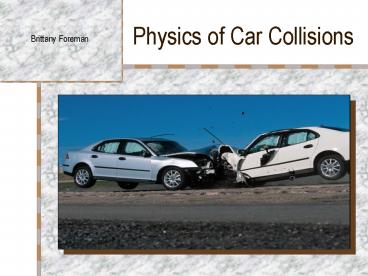Physics of Car Collisions PowerPoint PPT Presentation
1 / 11
Title: Physics of Car Collisions
1
Physics of Car Collisions
Brittany Foreman
2
Types of Collisions - Inelastic
- An inelastic collision occurs when two objects
collide and do not bounce away from each other. - Momentum is conserved.
- Kinetic energy is not conserved. Some of it is
turned into other forms of energy such as sound
and heat.
3
Types of Collisions - Elastic
- An elastic collision occurs when two objects
collide and bounce apart. - Both momentum and kinetic energy are conserved.
- Almost no energy is lost to sound, heat, or
deformation.
4
Impulse
- Impulse is the term to represent the force over a
certain amount of time. - In reference to car accidents, decelerating
itself is not harmful it is sudden decelerating
over a very short period of time that causes
damage. - F?t mvf mvi ? Impulse Equation
5
Impulse (continued)
This graph represents a situation where a person
collides with the steering wheel or dash. All
force is transmitted within a fraction of a
second.
This graph represents the use of a restraining
device such as a seat belt or airbag. It spreads
the impulse out over a longer period of time.
6
Severity Index
- Gives an idea of the chance a passenger has of
survival in a collision. - Takes into account both the magnitude of
acceleration and the length of time during which
it is experienced. - S.I. (a5/2) t, where alpha is the acceleration
in g, and t is the time of exposure in seconds. - A proposed specification is S.I. 1000 for the
human head.
7
Examples of Severity Index
- Person falling back in a chair 1
- Throwing a baseball at 40 km/hr against a wall
10,000 - Hammer hitting a nail in wood 3,000
- Hammer hitting a concrete wall 3,600,000
- Driving into concrete wall at 90 km/hr 24,000
8
Newton
- Law of Inertia (1st Law of Motion) - An object at
rest, or in uniform straight line motion, will
remain at rest, or in uniform straight line
motion, unless acted upon by a net external
force. - In reference to car collisions, this law deals
with whether or not the person is wearing a seat
belt. If not, the person continues forward to hit
the steering wheel, to hit the dash, or to be
evicted from the vehicle.
9
Newton
- 2nd Law of Motion - A net force acting on a body
produces an acceleration that is directly
proportional to the force upon the body and
inversely proportional to the mass of the body.
(Fma) - In reference to car collisions, this law deals
with the force of impact a car and its riders
exert on another car or object.
10
Newton
- 3rd Law of Motion For every action there is an
equal and opposite reaction. - In reference to car collisions, this law deals
with the collision itself. If the car hits a wall
with a certain force, that force will be exerted
onto the car by the wall, as well.
11
THE END
- Would you rather crack a rib
- or your
skull? - WEAR A SEAT BELT!!

